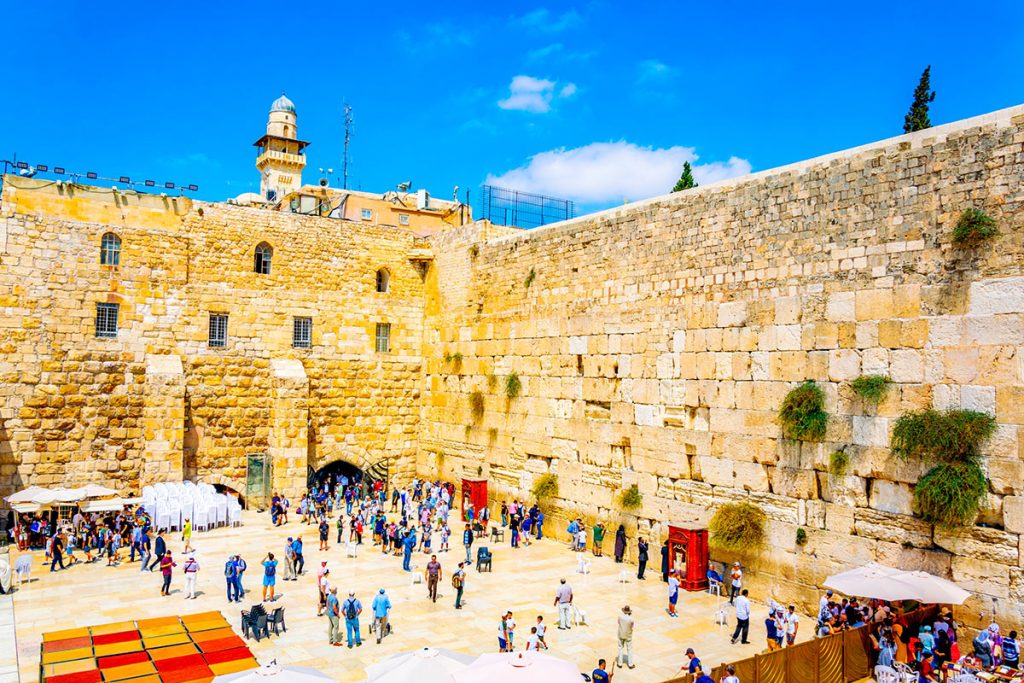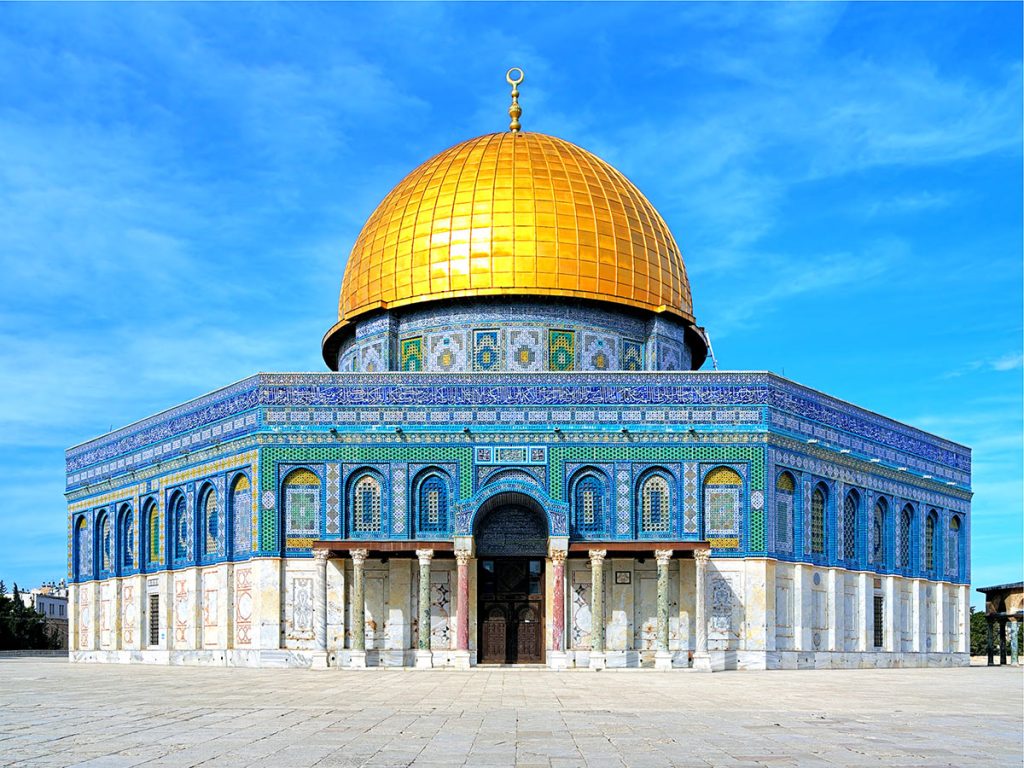Since I’ve been giving private tours of Jerusalem for over 10 years, I’ve decided to compile this cool itinerary for you to explore Jerusalem. If you’re on a rigid schedule but still want to see the city. You can cover these sites mentioned below in a day, and even though you don’t have to do it by the exact order listed here, I would recommend it. So Let’s start with Mt. Of Olives Viewpoint (you taxi there or use a car, I wouldn’t walk, it’s too steep). Trust me, as a private tour guide in Israel this is the place you should start your day. Overlooking the Old City, you’ll see Jerusalem in its splendor.

From here, you can see just below you the enormous Jewish Cemetery of Mt.Olives. In fact, if you walk around, you will find tombs dating back to the First Temple Period. This entire area, all the way down to the Kidron Valley, which separates The Old City and Mt. of Olives, became a huge Necropolis to the City of Jerusalem in the Canaanite Period. This Explains Why the City Never Passed the Kidron Valley; You Don’t Want Walk or Live Where Tombs Are.
After checking out the Best Viewpoint in Jerusalem now it’s time to plunge into the Old City and hit the Key Sites in Jerusalem:
What to do in Jerusalem within 24 Hours
Whenever I have a guided tour of Jerusalem I always choose to park my car at Karta Parking just under Alrov Mamilla Avenue (Mamilla Mall). Here you can easily walk to Jaffa Gate, the only gate that faces westwards towards the Mediterranean Sea. Most of the traffic that visited the Holy City Of Jerusalem usually came from that direction, coming from Jaffa Port. In more ways than one, up to the mid-nineteenth century, this area was the ‘central bus station of Jerusalem’.
What to do in Jerusalem with 24 Hours: The Christian Quarter
You can use David St, the main street that cuts through the Old City and divides the city into its four different quarters, to get to our first destination, The Church of the Holy Sepulchre in the very heart of the Christian Quarter. This is where according to most Christian Denominations, archeologists, historical records, and traditions point to the site where Jesus was crucified, buried, and If you are a faithful Christian also resurrected.

Inside the Church, there are many things to see like: Mt. Golgota, The Tomb of Jesus, St. Helena’s Chapel, including the last station of the Via Dolorosa. If you can get a private guide for this site, there is a lot to know about the Church that the Jerusalem guide books don’t mention. From there I would recommend connecting back to David St keep walking downhill, till you are connecting to the Cardo that goes right into the Jewish Quarter.
The Jewish Quarter: The Roman-Byzantine Cardo
If you entered the Jewish Quarter via the Cardo then you are seeing the actual remains of the Byzantine Cardo dated to the Roman-Byzantine Period. This main street of Jerusalem goes back in time two thousand years. In general, I should add, that since the city of Jerusalem had never experienced complete destruction since the Roman Period, we are walking the same infrastructure, or in other words, the same main Streets, as they were originally laid down a couple of thousands of years back, by Hadrian the Roman Emperor that rebuilt Jerusalem as a Roman Pagan city in the second century and named it Aelia Capitolina.
Best Restaurants in the Muslim Quarter

Map of Madaba
Further along the Cardo, you can find a replica of the Map of Madaba. The Cardo you are walking in is clearly visible in it. The Map was found accidentally in Madaba, Jordan. It’s a map of the Middle East and contains the oldest surviving detailed cartographic depiction of Jerusalem. It’s a mosaic floor, a part of an ancient church dating from the Byzantine period.

The floor was compiled of one million little rectangular stones that form a ‘snap picture’ of Byzantine Jerusalem. You can see the Church of the Holy Sepulcher in the very center of the map. Deliberately centered on the map for theological reasons. Since the Church of the Holy Sepulchre is the ‘new temple’; taking the place of the destroyed Jewish Temple, it has to be right there smack in the center of Jerusalem because it’s the new center of the world.
The Herodion Quarter – The Wohl Museum
Beneath the houses of the newly built Jewish Quarter, there is an archaeological gem waiting for you to discover on your way to the Western Wall (The Whaling Wall). It is the remains of the Jewish upper-class residential area dating from the first century C.E. You can enter their cellars, living rooms, see the mosaic floor, and many archaeological finds that were found in the excavations – The Herodian Mansion is a must-see site!
The Western Wall (Wailing Wall)
The famous Wailing Wall is an actual remnant from the time of the 2nd Temple. The place where millions and millions of Jews came from all over the world to lament the destruction of the Second Temple, destroyed by the Romans in the year 70 C.E. The term ‘Wailing Wall’ is a non-Jewish term. Christians and Muslims that use to see the Jews next to the Wall, shedding tears lamenting the destruction of the Temple, but also since it was the climax of their pilgrimage to the Promised Land, gave it the name – the Wailing Wall. Jews prefer to call it the Western Wall or the Wall (Ha-Kotel in Hebrew).

What Makes the Western Wall So Holy?
It’s worth clarifying to those that aren’t well informed, the Western Wall isn’t a part of the 2nd Temple. It’s one of the four retaining walls that Herod the Great built in order to create more space on Temple Mount. that was actually too small to support the monumental Second Temple Herod had in mind. The area today that people come to and visit is one of the few places visible since most of the Western Wall was used as a retaining wall to establish the current Muslim Quarter established in the fourteenth century. Today when you’re standing next to the Wall you can mostly see later additions and not the original Herodian Masonry of the Western Wall. Only if you’ll come real close you can some of the original building blocks of the Wall.
The Muslim Quarter
With the time we’ve left for the tour we’ll dedicate it to visiting the Muslim Quarter, specifically Temple Mt. Sadly we can’t enter into the Muslim holy sites but to at the very least, we can take a peek and get really close. There is only one entrance for non-Muslims and that is the entrance next to the Western Wall (Mughrabi Gate). After entering, the first site we’ll encounter would be the famous Al-Aqsa Mosque.
The Al-Aqsa Mosque
In the Quran it’s told: “Blessed is He who took His servant by night from the Beautiful mosque to the Al-Aqsa Mosque, whose surroundings We have blessed”
(The Quran 17:1)
As you can read Jerusalem isn’t mentioned in the verse above (Jerusalem isn’t mentioned even once in the Quran). But, in the Hadith, the oral interpretations of the Quran, considered to be the words of Muhammad; The Al-Aqsa mosque is identified in Jerusalem. For that reason, Jerusalem is the third holiest city for the Muslims after Mecca and Medina and forms a part of their Hajj (the holy pilgrimage every Muslim must do in his life), one of the five basic commandments in Islam.

The structure you see today isn’t the original structure that was built by the Umayyad Caliph Al-Walid I in the 8th century C.E. The original structure couldn’t survive natural disasters like earthquakes since it was made out of wood. The current structure you are seeing is dated to the Crusader Period. The real Jewel here on Temple Mt. thou is the Dome of the Rock (The Golden Dome).
The Dome of the Rock
Probably the most magnificent structure today standing in Jerusalem. Visible from the distance it’s not possible to take one’s eyes off it. Unlike the Al-Aqsa Mosque, this is the original Structure. The Umayyad Caliph, Abd Al-Malik, was the one that erected the building at the end of the 7th century. By getting closer you can appreciate the Arab Calligraphy decorating the entire structure with verses from the Quran. If you’ll circle around the structure you’ll notice it has an octagonal shape.

So Muslim Tradition points to this location as the site where Muhammad ascended to heaven, receiving the five holy prayers. Upon coming out from Temple Mt. We’ll exit via the most impressive gate of Temple Mt. The Cotton Merchant’s Gate. Built by the ruler of Damascus, Tankiz, during the reign of Mamluk Sultan Ibn Qalawun, as marked by an inscription over the door.
The gate is elegantly styled with Islamic architecture with alternating rows of black and white stones (Ablaq); Ornamented vaulting as shaped as Stalactites falling off the ceiling. (Muqarnas).
The Cotton Merchant’s Market
After coming out from the gate you will see this extensive enclosed market. This market is dated from the 14th century and has kept its appearance since then. Amir Tankiz was the one that created the market. He was the governor of Damascus for twenty-eight years, something that was quite unusual in those days. Since he was in power for so long he was able to develop the Holy City of Jerusalem greatly. The Market is built upon the ruins of a crusader market that was demolished.


